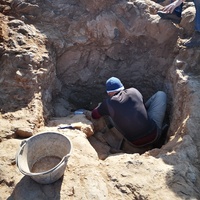Oral presentations by Helena Ribeiro

No âmbito de crescentes preocupações interdisciplinares este artigo dá a conhecer os resultados d... more No âmbito de crescentes preocupações interdisciplinares este artigo dá a conhecer os resultados do estudo polínico de duas colunas recolhidas na estação arqueológica do Corgo, Azurara, Vila do Conde, cuja correlação foi complementada com uma descrição sedimentológica. Trata-se de uma estação arqueológica de grande amplitude, com níveis de ocupação da Idade do Bronze, senão mesmo anteriores, inclusa no litoral Norte de Portugal e localizada a cerca de dois quilómetros para SE da foz actual do Ave. Os resultados permitiram: identificar os tipos polínicos presentes, existindo dominância de herbáceas; reconhecer indícios de antropização, verificando-se variações ao longo do perfil e observar indicadores de actividade agrícola. O conjunto de dados foi comparado com outras análises polínicas realizadas em estações arqueológicas da Idade do Bronze do Noroeste português, tendo como objectivo último tentar perceber regularidades ou dissemelhanças. 1 CGUP.
Papers by Helena Ribeiro

Aerobiologia, 2019
In this work, we performed a palynological analysis of soil sampled from the footwear in order to... more In this work, we performed a palynological analysis of soil sampled from the footwear in order to provide their spatial and temporal classification. The sampling was performed in the shoes of 20 volunteers, in two different periods: autumn-winter and spring 2016/2017. The volunteers belonged to the same geographic region within a radius of 500 m. During the laboratorial treatment, the pollinic content present in the shoes sole was concentrated applying several treatments to destroy the exogenous material. A hierarchical cluster analysis was performed to verify whether it was possible to distinguish the samples based on their pollen assemblages. All the samples showed pollinic content, even when the shoes were apparently clean. The pollen types found were similar across the sampling period although with different pollen assemblages. In the winter samples, there was a prevalence of Fraxinus, Myrtaceae, Pinaceae (mostly Cedrus) and Poaceae pollen, while in the spring pollen of Olea, Poaceae, Pinaceae (namely Pinus) and Quercus was observed. Our results also demonstrated the discrimination between close sites (approximately 200 m), showing that the use of palynological analysis in footwear allows the collection of temporal and spatial information that can be used in forensic investigations.

Journal of Iberian Geology, 2019
Palynological, geochronological, and sedimentological analyses were conducted on samples from dif... more Palynological, geochronological, and sedimentological analyses were conducted on samples from different depositional units of well-preserved marine, fluvial and palustrine sedimentary deposits from Vila Nova de Gaia located at the northwestern Portuguese coast. The studied deposits occur on two terraces: Terrace A—Lavadores (18 m to 33 m) and Terrace B—Canidelo (50 m). Chronological and sedimentological features allowed to date the deposits to the Upper Pleistocene until the last glacial period, being observed an evolution from a depositional setting in a marine intertidal zone, passing to a fluvial environment and ending in a palustrine/lagunar environment with possible periglacial influence. Pollen assemblages collected in the fluvial sedimentary horizons also suggested changes in the environmental conditions. A pollen content with good representation of arboreal species (Quercus, Pinus, Castanea, Fraxinus, Salix, Betula and Corylus), changed to a vegetation environment dominated by non-arboreal species, such as Poaceae, Plantago and Asteraceae. The top horizons, corresponding to a palustrine/lagunar environment, presented a pollen profile completely dominated by non-arboreal species, with minimal tree representation (Prunus, Quercus, Pinus and Castanea) which, combined with sedimentological characteristics may point to a more dry and cold climate than nowadays.ResumenEn este estudio, se realizaron análisis palinológicos, geocronológicos y sedimentológicos en muestras de diferentes unidades de depósitos sedimentarios marinos, fluviales y palustres bien conservados de Vila Nova de Gaia, ubicados en el margen portugués del Atlántico norte. Los depósitos estudiados se sitúan en dos terrazas: Terraza A - Lavadores (de 8 a 33 m) y Terraza B - Canidelo (50 m). Las características cronológicas y sedimentológicas permitieron datar los depósitos desde el Pleistoceno superior hasta el último período glacial, observándose una evolución desde un entorno de deposición en una zona intermareal marina, pasando a un entorno fluvial y terminando en un entorno palustre/lagunar en un área con posible influencia periglacial. Los datos de polen recolectados de los horizontes sedimentarios fluviales también sugirieron cambios en las condiciones ambientales. Un contenido de polen con una buena representación del estrato arbóreo (Quercus, Pinus, Castanea, Fraxinus, Salix, Betula y Corylus), à cambiado a un entorno de vegetación dominado por especies no arbóreas, tales como Poaceae, Plantago y Asteraceae, y con mínima representación de árboles. Los horizontes superiores, correspondientes a un entorno palustre/lagunar, presentaron un perfil de polen completamente dominado por especies no arbóreas, indicando un entorno de vegetación abierta con una representación mínima de árboles (Prunus, Quercus, Pinus y Castanea) lo que, combinado con las características sedimentológicas, puede apuntar un clima más seco y frío que hoy en día.

The Journal of Agricultural Science, 2018
Phenological models for predicting the grapevine flowering were tested using phenological data of... more Phenological models for predicting the grapevine flowering were tested using phenological data of 15 grape varieties collected between 1990 and 2014 in Vinhos Verdes and Lisbon Portuguese wine regions. Three models were tested: Spring Warming (Growing Degree Days – GDD model), Spring Warming modified using a triangular function – GDD triangular and UniFORC model, which considers an exponential response curve to temperature. Model estimation was performed using data on two grape varieties (Loureiro and Fernão Pires), present in both regions. Three dates were tested for the beginning of heat unit accumulation (t0 date): budburst, 1 January and 1 September. The best overall date was budburst. Furthermore, for each model parameter, an intermediate range of values common for the studied regions was estimated and further optimized to obtain one model that could be used for a diverse range of grape varieties in both wine regions. External validation was performed using an independent data ...

Aerobiologia, 2018
In the last years, pollen-related respiratory allergies have increased worldwide. In the case of ... more In the last years, pollen-related respiratory allergies have increased worldwide. In the case of Cupressaceae pollen, allergy symptoms appearing during the winter are often confused with generic respiratory diseases such as the common cold, influenza syndrome, among others. The aim of our study was to monitor the atmospheric of Cupressaceae pollen in the city of Porto, investigate its diurnal variation, as well as find the meteorological factors influencing its atmospheric concentration. Airborne pollen sampling was performed using a 7-day Hirsttype volumetric spore trap for 5 years (2013-2017). Cupressaceae main pollen season, interannual and diurnal variations, as well as correlations with the meteorological parameters were determined. During the study period, 2015 was the year that registered the highest annual pollen concentration, while 2016 presented the lowest. Cupressaceae pollen season occurred during the winter, being February the month with the highest concentration. The diurnal distribution pattern presents a well-defined peak concentration in the morning hours (9 a.m.-12 a.m.), which decays abruptly in the early afternoon. Finally, airborne pollen concentration and meteorological factors presented significant correlations, with temperature being the most influent variable.

Parietaria judaica pollen is able to induce severe allergic symptoms, mainly due to its high poll... more Parietaria judaica pollen is able to induce severe allergic symptoms, mainly due to its high pollen output and the long persistence in the atmosphere. Aim: We intended to study the aerobiology and allergenic proteins of Parietaria judaica pollen collected in an urban area of the Porto region. Methods: We adopted aerobiological and immunological techniques to study the annual airborne pollen concentrations from 2003 to 2012 and the immunore- activity of P. judaica pollen extracts against 21 sensitized patient sera. Results: Parietaria spp. pollen is present in the atmosphere of Porto all year long, representing 17% of the total pollen spectrum. The highest airborne pollen con- centrations were mainly found from April-August. From the selected patients with pollen allergy, 34.2% showed sensitization to Parietaria spp. pollen extracts. Among these, 84.5% were only positive to Parietaria judaica and 8.5% to its counterpart Parietaria officinalis. The most prevalent protein bands of P. j...

Forensic Science International, 2009
In this study, the colour of 23 sediment samples collected in different Portuguese beaches in the... more In this study, the colour of 23 sediment samples collected in different Portuguese beaches in the North (Entre-Douro and Minho) and 33 in the South (Algarve) was tested. Spectral colour parameters (L*a*b*) were measured after several presentation/pre-treatment methods: drying at 40 degrees C, sieving (<150 and <63 microm) and ashing at 850 degrees C, using a Konica Minolta CM-2600d spectrophotometer. A descriptive statistical analysis with L*a*b* values for each presentation/pre-treatment method was performed to ascertain within-sample reproducibility followed by a hierarchical cluster analysis to obtain significant discrimination between samples using colour analysis. The samples analysed presented a colour closest to red and yellow continuums and a lightness close to the pale side of the L*a*b* system colour sphere with samples collected in the North presenting analysis on average darker L values than the samples collected in the South. The cluster analysis, dried, unsieved bulk samples L*a*b* values gave the best discrimination between samples. The clusters analysis dried, unsieved bulk samples-dried, sieved <150 microm fraction set allowed better discrimination between samples compared with the dried, sieved <63 microm fraction set or dried, unsieved bulk samples-ashed bulk, unsieved samples set and even with dried, unsieved bulk samples/dried, sieved <150 microm fraction/dried, sieved <63 microm fraction/ashed bulk, unsieved samples considered all together.

Atmospheric Environment, 2008
The increase of allergenic symptoms has been associated with air contaminants such as ozone, part... more The increase of allergenic symptoms has been associated with air contaminants such as ozone, particulate matter, pollen and fungal spores. Considering the potential relevance of crossed effects of non-biological pollutants and airborne pollens and fungal spores on allergy worsening, the aim of this work was to evaluate the influence of non-biological pollutants and meteorological parameters on the concentrations of pollen and fungal spores using linear correlations and multiple linear regressions. For that, the seasonal variation of ozone, particulate matter with an equivalent aerodynamic diameter smaller than 10 mm, pollen and fungal spores were assessed and statistical correlations were analysed between those parameters. The data were collected through 2003-2005 in Porto, Portugal. The linear correlations showed that ozone and particulate matter had no significant influence on the concentration of pollen and fungal spores. On the contrary, when using multiple linear regressions those parameters showed to have some influence on the biological pollutants, although results were different depending on the year analysed. Among the meteorological parameters analysed, temperature was the one that most influenced the pollen and fungal spores airborne concentrations, both when using linear and multiple linear correlations. Relative humidity also showed to have some influence on the fungal spore dispersion when multiple linear regressions were used. Nevertheless, the conclusions for each pollen and fungal spore were different depending on the analysed period, which means that the correlations identified as statistically significant may not be, even so, consistent enough. Furthermore, the comparison of the results here presented with those obtained by other authors for only one period should be made carefully.
… de Ciências da …, 2010
A. GUEDES [email protected] (Universidade do Porto, Centro de Geologia, Departamento de Geoci... more A. GUEDES [email protected] (Universidade do Porto, Centro de Geologia, Departamento de Geociências, Ambiente e Ordenamento do Território da Faculdade de Ciências) ... H. RIBEIRO [email protected] (Universidade do Porto, Centro de Geologia)
VIII CNG …, 2010
Discriminação de amostras de sedimentos para aplicação forense Discrimination of sediment samples... more Discriminação de amostras de sedimentos para aplicação forense Discrimination of sediment samples for forensic application

Aerobiologia, 2014
ABSTRACT Airborne pollen calendars are useful to estimate the flowering season of the different p... more ABSTRACT Airborne pollen calendars are useful to estimate the flowering season of the different plants as well as to indicate the allergenic potential present in the atmosphere at a given time. In this study, it is presented a 10-year survey of the atmospheric concentration of allergenic pollen types. Airborne pollen was performed, from 2003 to 2012, using a 7-day Hirst-type volumetric trap. The interannual variation of the daily mean concentration of the number of pollen grains and the main pollen season was determined as well as the hourly variations and correlation with meteorological parameters. During the study period, 18 different allergenic pollen types were considered based on its representativeness on the total annual airborne pollen concentration. The lowest annual concentrations were sampled in 2006 and the highest in 2007. The highest airborne pollen concentration was found during early spring and early summer. On the contrary, December was the month with the lowest pollen concentration. The major pollen sampled belongs to trees followed by weeds and grasses, being the most representative pollen types in the atmosphere: Urticaceae, Platanus, Poaceae, Pinaceae, Cupressaceae, Acer, Quercus, Castanea, Plantago, Alnus, Olea europaea, Betula, Myrtaceae and Populus. Intradiurnal distribution patterns of the pollen types studied presented differences with some taxa being predominantly sampled in the morning (9–11 a.m.) while others in first night hours (between 9 and 12 p.m.). Significantly correlations were found between the airborne pollen concentration and meteorological parameters.

Aerobiologia, 2003
The annual airborne pollen variation of the Porto region was studied from November 2001 to Octobe... more The annual airborne pollen variation of the Porto region was studied from November 2001 to October 2002 using a Cour type sampler. A total of 170 × 10 6 grains m −2 belonging to 63 taxa was observed. The vegetation surrounding the sampling point includes ornamental, non-ornamental trees, shrubs and herbaceous species. The main pollen types were Cupressaceae, Gramineae, Hamamelidaceae, Pinaceae, Urticaceae, Quercus spp., Acer spp., Myrtaceae, Caryophyllaceae, Oleaceae, Betulaceae and Plantago spp. that represented 88% of the Porto pollen spectrum. Gramineae, Cupressaceae, Myrtaceae, Oleaceae, Pinaceae and Urticaceae pollen are found throughout the year. Concerning total pollen concentration, the distribution throughout the year is very irregular, with several annual peaks, with the maximum concentration registered between the end of March and the first two weeks of April and the lowest observed during autumn.
Aerobiologia, 2009
Because fungal spore emission intensity varies throughout the year and even throughout the day, s... more Because fungal spore emission intensity varies throughout the year and even throughout the day, study of the hourly distribution is an important aspect of aerobiological monitoring. The objective of this work was to determine seasonal and intradiurnal variation of allergenic airborne fungal spores in urban and rural areas. The aerobiological study was performed from 2005 to 2007 using Hirst-type volumetric

Exposure to ambient air pollution has been linked to a number of health outcomes, starting from m... more Exposure to ambient air pollution has been linked to a number of health outcomes, starting from modest transient changes in the respiratory tract and impaired pulmonary function, continuing to restrict activity/reduce performance and to the increase emergency rooms visits, hospital admissions or mortality. The increase of allergenic symptoms has been associated with air contaminants such as ozone, particulate matter, fungal spores and pollen. Considering the potential relevance of crossed effects of nonbiological pollutants and airborne pollens and fungal spores on allergy worsening, the aim of this work was to evaluate the influence of non-biological pollutants (O3 and PM10) and meteorological parameters on the concentrations of pollen and fungal spores using multiple linear regressions. The data considered in this study were collected in Oporto which is the second largest Portuguese city, located in the North. Daily mean of O3, PM10, pollen and fungal spore concentrations, tempera...
Journal of Apicultural Research, 2007











Uploads
Oral presentations by Helena Ribeiro
Papers by Helena Ribeiro